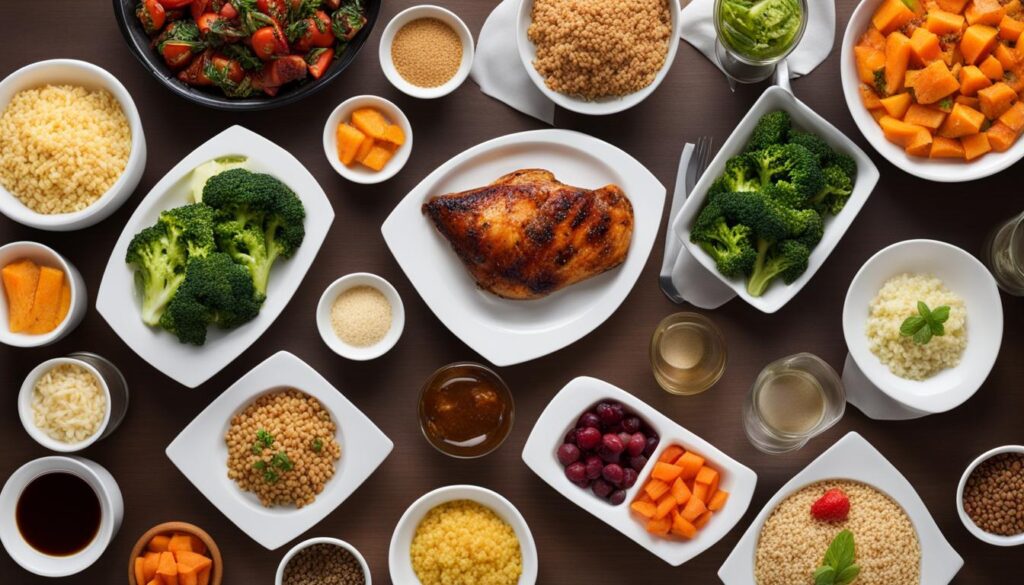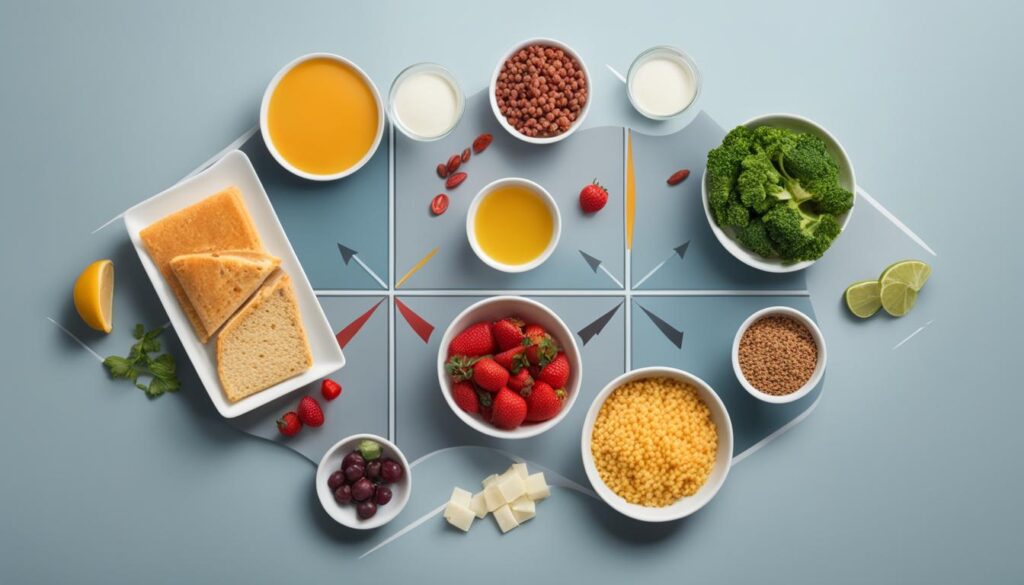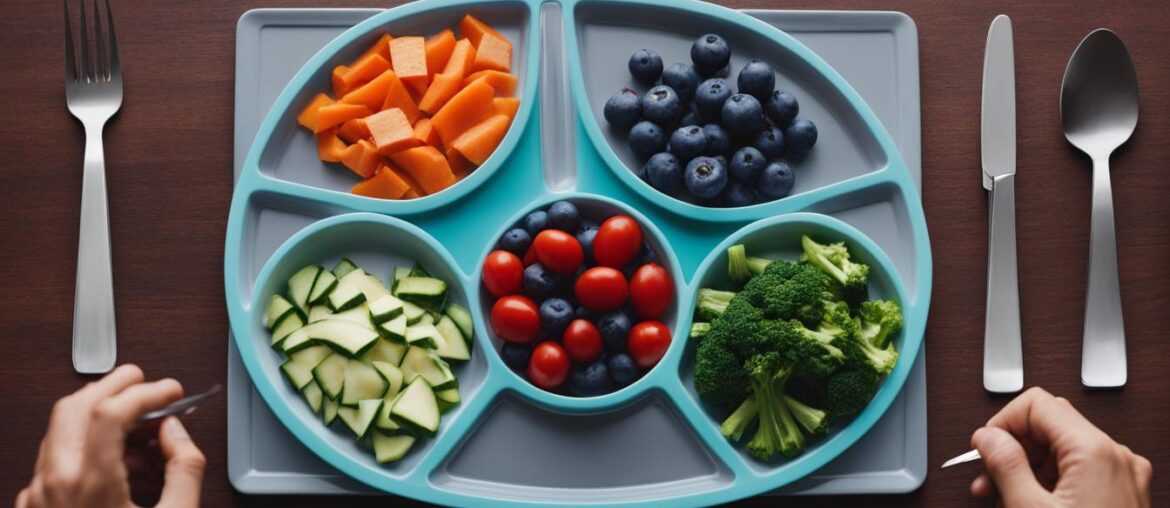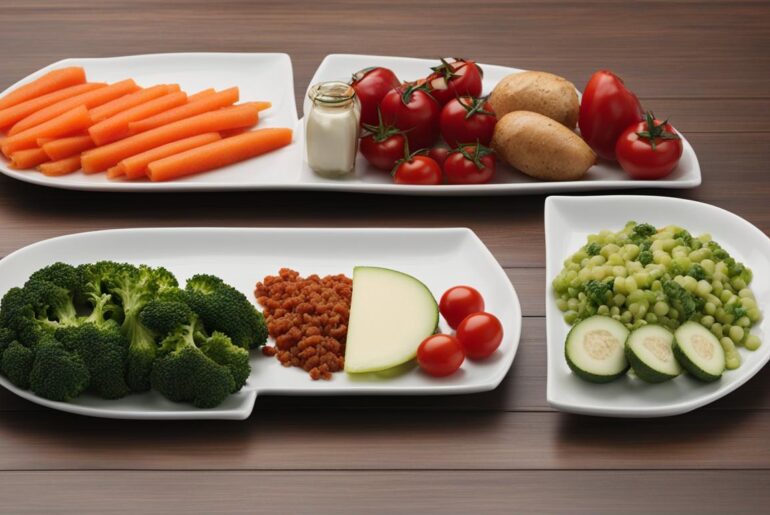Portion control plays a crucial role in maintaining a healthy diet and managing weight. With oversized portions becoming the norm these days, it’s important to find effective ways to control our portion sizes. In this article, I will explore practical portion control hacks that can help you eat healthier and maintain a balanced diet. These tips have been gathered from reputable sources and are backed by scientific evidence.
Key Takeaways:
- Portion control is essential for maintaining a healthy diet and managing weight.
- Using a portion control plate can provide a visual guide and help you manage your portions effectively.
- Practical tips for portion control include using smaller plates, filling half your plate with non-starchy vegetables, and measuring serving sizes.
- When dining out, choose smaller portions, opt for appetizers, or share meals to practice portion control.
- Overcoming common challenges in portion control, such as emotional eating, mindless eating, and social influences, is crucial for success.
Why Use a Portion Control Plate?
Using a portion control plate can offer numerous benefits in managing your portion sizes effectively. These specially designed plates provide a visual guide that allows you to divide your meals into appropriate sections for each food group, ensuring a balanced and controlled diet. Let’s explore the advantages of incorporating a portion control plate into your eating habits.
Benefits of Using a Portion Control Plate
1. Improved Portion Awareness:
When using a portion control plate, you become more mindful of the size and composition of your meals. The plate’s divided sections provide a clear visual representation of the recommended proportions for different food groups, enhancing your understanding of appropriate portion sizes.
2. Better Control Over Calorie Intake:
By following the portion guidelines on a control plate, you can manage your calorie intake more effectively. This can be particularly helpful for individuals aiming to lose or maintain weight, as it promotes portion moderation and prevents overeating.
3. Support for Weight Management Goals:
A portion control plate serves as an essential tool for individuals looking to manage their weight. It encourages mindful eating habits, helping you maintain a healthy balance between different food groups and preventing excessive consumption of calorie-dense foods.
To further illustrate the benefits of using a portion control plate, consider the following table:
| Benefit | Description |
|---|---|
| Improved Portion Awareness | Visual guidance for appropriate portion sizes |
| Better Control Over Calorie Intake | Prevents overeating and promotes portion moderation |
| Support for Weight Management Goals | Encourages healthy eating habits for weight control |
Note: The table above summarizes the benefits of using a portion control plate for easy reference.
By utilizing a portion control plate, you can take a proactive approach to portion management, promoting a balanced and nutritious diet. Let’s explore practical tips and techniques for effective portion control in the following section.
Practical Tips for Portion Control
When using a portion control plate, there are several practical tips you can follow to help you achieve your goals of portion control and weight loss.
1. Use smaller plates and bowls
Trick your brain into perceiving larger portions by using smaller plates and bowls. This can create the illusion of a full plate while actually reducing the amount of food you consume.
2. Fill half of your plate with non-starchy vegetables
To control portion sizes and increase nutrient intake, fill half of your portion control plate with non-starchy vegetables. This not only provides essential vitamins and minerals but also helps you feel fuller for longer.
3. Measure serving sizes
Accurately measuring serving sizes can give you a better understanding of what a proper portion looks like. Use measuring cups or a kitchen scale for a more precise measurement and avoid overeating.
4. Pre-portion snacks
To avoid mindless snacking and overeating, pre-portion your snacks into small containers or bags. This helps you control the amount you eat and prevents you from consuming more than intended.
5. Practice the “plate method”
The “plate method” is an effective strategy for portion control. Fill half your plate with non-starchy vegetables, one quarter with lean protein, and one quarter with whole grains. This balanced approach ensures you’re getting a variety of nutrients in appropriate portions.
6. Slow down your eating
Take your time when eating and savor each bite. Eating slowly allows your brain to register feelings of fullness, preventing you from overeating.
7. Be mindful of high-calorie foods
Awareness of high-calorie foods is essential for portion control. Be mindful of foods that are calorie-dense and limit your portions accordingly. This helps you maintain a calorie deficit and supports weight loss.
8. Drink water before meals
Drinking a glass of water before meals can help curb your appetite and prevent overeating. Water also helps keep you hydrated and supports overall well-being.
9. Opt for whole foods over processed options
Choose whole, unprocessed foods whenever possible. These foods tend to be more filling and nutrient-dense, helping you stay satisfied and maintaining portion control.
Practical Tips Summary:
- Use smaller plates and bowls
- Fill half your plate with non-starchy vegetables
- Measure serving sizes
- Pre-portion snacks
- Practice the “plate method”
- Slow down your eating
- Be mindful of high-calorie foods
- Drink water before meals
- Opt for whole foods over processed options
| Tips | Description |
|---|---|
| 1. Use smaller plates and bowls | Trick your brain into perceiving larger portions by using smaller plates and bowls. |
| 2. Fill half your plate with non-starchy vegetables | Control portion sizes and increase nutrient intake by filling half your plate with non-starchy vegetables. |
| 3. Measure serving sizes | Accurately measure serving sizes to understand proper portions and avoid overeating. |
| 4. Pre-portion snacks | Avoid mindless snacking by pre-portioning snacks into small containers or bags. |
| 5. Practice the “plate method” | Follow the “plate method” of filling half your plate with vegetables, one quarter with lean protein, and one quarter with whole grains. |
| 6. Slow down your eating | Eat slowly to give your brain time to register feelings of fullness and prevent overeating. |
| 7. Be mindful of high-calorie foods | Be aware of high-calorie foods and adjust your portions accordingly to maintain a calorie deficit. |
| 8. Drink water before meals | Drink water before meals to curb your appetite and prevent overeating. |
| 9. Opt for whole foods over processed options | Choose whole, unprocessed foods for their nutritional value and satisfying properties. |
Portion Control Techniques for Dining Out

When dining out, it can be challenging to control portion sizes. However, there are techniques you can use to overcome this challenge.
Navigate restaurant menus wisely by:
- Choosing smaller portions
- Opting for appetizers
- Sharing meals with others
Being mindful of social and environmental influences on portion sizes is also crucial. Restaurants often serve oversized portions or have all-you-can-eat buffets that can tempt you into overeating. By being aware of these influences and making conscious choices, you can still practice portion control even when eating out.
Example:
“I always make it a point to review the menu thoroughly and look for smaller portion options or appetizers that allow me to enjoy a variety of dishes without overeating. By sharing meals with my dining companions, we can sample different dishes and control our portion sizes. It’s important to remember that dining out doesn’t mean sacrificing portion control.”
— Jessica, a health-conscious diner
| Portion Control Technique | Instructions |
|---|---|
| Choose smaller portions | Select dishes labeled as “small” or “light” on the menu. Request half portions or ask the server to pack half the meal for leftovers. |
| Opt for appetizers | Consider ordering appetizers as a main course or sharing multiple appetizers with your dining party. |
| Share meals with others | Split an entree with a friend or family member to control portion sizes and enjoy different flavors. |
Overcoming Common Challenges in Portion Control
Portion control can be challenging due to various obstacles that can hinder progress on your journey towards a healthier lifestyle. Two common challenges that you may encounter are emotional eating and portion distortion, both of which can lead to overeating and disrupt your portion control efforts. To overcome these challenges, it is crucial to identify emotional triggers and find alternative coping mechanisms that do not involve food. By addressing your emotional needs through activities such as journaling, exercising, or talking to a trusted friend or therapist, you can prevent emotional eating episodes and maintain control over your portion sizes.
Mindless eating is another challenge that many individuals face when trying to control their portion sizes. Being distracted while eating or not paying attention to the food on your plate can lead to overconsumption without realizing it. To address this challenge, it is recommended to practice mindfulness while eating, being fully present in the moment and savoring each bite. By slowing down and engaging your senses, you can enhance portion awareness and develop a better understanding of your body’s hunger and fullness cues.
Social and environmental influences also play a significant role in portion control, as they can often lead to larger portion sizes or unhealthy food choices. To overcome these influences, it is important to make mindful choices and consciously create a supportive environment that aligns with your portion control goals. For example, when dining out with friends, you can suggest restaurants that offer healthier options or share meals to reduce portion sizes. By surrounding yourself with people who support your goals and making intentional decisions, you can overcome social and environmental influences and stay on track with your portion control journey.
Strategies to Overcome Common Challenges in Portion Control
| Challenge | Recommendations |
|---|---|
| Emotional Eating | Identify emotional triggers and find alternative coping mechanisms. Seek support from friends, family, or professionals. |
| Portion Distortion | Learn to recognize appropriate portion sizes through visual aids and measuring tools. Practice dividing your plate into sections for different food groups. |
| Mindless Eating | Practice mindful eating by slowing down, savoring each bite, and paying attention to your body’s hunger and fullness cues. |
| Social and Environmental Influences | Make conscious choices when dining out or attending social events. Surround yourself with supportive individuals who share your health goals. |
By implementing these strategies and remaining committed to your portion control goals, you can successfully overcome common challenges and maintain a balanced and healthy diet. Remember, portion control is an ongoing process that requires practice and mindfulness. Stay focused on your journey, celebrate small victories, and be kind to yourself along the way.
Incorporating Portion Control into Daily Life

Portion control should not be seen as a temporary solution but rather as a sustainable lifestyle change. It’s important to incorporate portion control into your daily life to achieve long-term success. By adopting mindful eating techniques, pre-portioning meals and snacks, understanding portion sizes, managing emotional and social triggers, and making conscious choices when eating out, you can successfully maintain portion control habits (see my post here).
One effective technique for incorporating portion control into your daily routine is practicing mindful eating. This involves paying attention to your body’s hunger and fullness cues, eating slowly, and savoring each bite. By being present and mindful during meals, you are more likely to recognize when you’ve had enough, preventing overeating.
Another strategy is pre-portioning your meals and snacks. By dividing your food into appropriate portions beforehand, you can avoid mindlessly eating larger quantities than necessary. This can be done by using portion control containers or measuring utensils to ensure you’re consuming the right amount of each food group (check this post out).
Understanding portion sizes is also crucial in maintaining portion control. Familiarize yourself with recommended serving sizes for different food groups and measure your portions accordingly. This can help you develop a better understanding of what constitutes a balanced meal and prevent overeating.
Managing emotional and social triggers is equally important. Emotional eating can lead to consuming larger portions or indulging in unhealthy foods. Finding alternative ways to cope with emotions, such as engaging in physical activity, practicing relaxation techniques, or seeking support from friends and family, can help you break the cycle of emotional eating.
When dining out or attending social gatherings, making conscious choices can help you stay on track with portion control. Look for healthier options on the menu, ask for dressings or sauces on the side, and share meals with others to prevent overeating. By being proactive and mindful in social situations, you can enjoy your favorite foods without compromising your portion control goals.
Tracking your progress and staying motivated are essential for maintaining portion control habits. Keep a food journal or use a portion control plate tracker to monitor your meals and portion sizes. Celebrate your achievements, no matter how small, and seek support from others who share your goals. Having a support system can keep you accountable and motivated on your portion control journey.
Remember, creating a sustainable portion control routine takes time and practice. Be patient with yourself and focus on making gradual changes. By incorporating these strategies into your daily life, you can achieve long-term success in maintaining portion control and living a healthier, more balanced lifestyle.
The Role of Portion Control in a Healthy Lifestyle
Portion control is a fundamental aspect of maintaining a healthy lifestyle and plays a significant role in weight management, balanced nutrition, and overall well-being. By practicing portion control, you can ensure that you provide your body with the appropriate amount of nutrients it needs without overindulging.
One of the key benefits of portion control is its ability to prevent overeating (check out my post on benefits of portion control here). By being mindful of the portion sizes you consume, you can avoid exceeding your body’s energy requirements and reduce the risk of consuming excess calories. This can be particularly beneficial for individuals looking to manage their weight or achieve weight loss goals.
Additionally, portion control can improve portion awareness, helping you develop a better understanding of appropriate serving sizes for different food groups. This awareness can be particularly useful for individuals who struggle with estimating portion sizes accurately. By using a portion control plate guide, you can visually divide your meals into appropriate sections for each food group, ensuring a balanced and nutritious diet.
Incorporating portion control into your daily routine can have a positive impact on your overall health and quality of life. By managing portion sizes, you can ensure that you provide your body with the right balance of macronutrients and essential vitamins and minerals, supporting optimal physiological function (check this post out).
Benefits of Portion Control:
- Prevents overeating
- Aids in weight management and weight loss
- Improves portion awareness
- Promotes balanced nutrition
- Supports overall well-being
By incorporating portion control into your daily routine, you can make significant progress towards achieving your health and wellness goals. Whether you’re looking to lose weight, maintain a balanced diet, or simply improve your overall eating habits, portion control can be a valuable tool to guide you towards a healthier lifestyle.
Conclusion
Mastering portion control plate usage effectively is a journey that requires conscious effort and mindfulness. By implementing practical tips and strategies, you can achieve portion control and maintain a healthy lifestyle.
One valuable tip is to use smaller plates, which can trick your brain into perceiving larger portions. Additionally, filling half your plate with vegetables ensures a balanced meal and increases nutrient intake. Measuring serving sizes, being aware of social and environmental influences, and pre-portioning snacks are also essential techniques for portion control.
It’s important to remember that portion control is unique to each individual, and finding a balance that works for you is essential. By prioritizing nourishing your body with appropriate portions, you’ll be on your way to a healthier and more mindful lifestyle. Incorporate portion control plate tips and recommendations into your daily routine for long-term success in managing your weight and maintaining a balanced diet.




